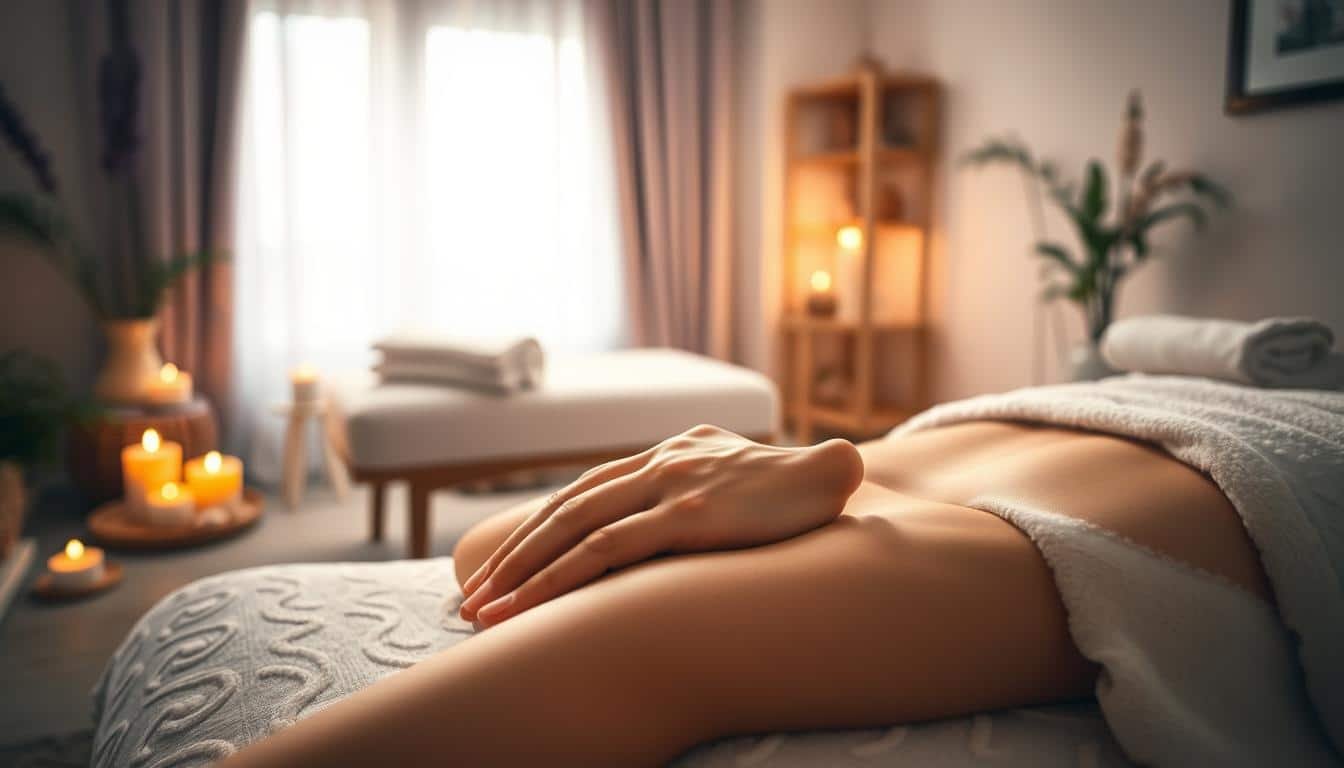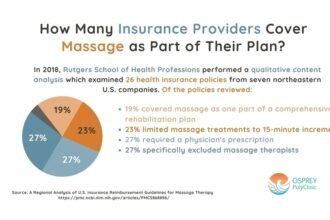Ever felt sore after a relaxing massage? You’re not alone. Many people experience this common sensation. It’s like your body ran a marathon while you were enjoying the spa.
Post-massage muscle soreness is often a good sign. It shows your body is responding to the treatment. This ache is usually brief, lasting about a day. It’s similar to feeling sore after a workout.
Why does it happen? Is it always okay? Understanding post-massage aches can improve your bodywork sessions. It helps to know what’s normal and what’s not.
Let’s explore post-massage soreness and how to find relief. Whether you’re new to massages or a, this info can enhance your experience.
Key Takeaways
- Post-massage aches are common and usually temporary
- Soreness can indicate effective muscle manipulation
- Different massage types may cause varying levels of discomfort
- Hydration plays a crucial role in managing post-massage aches
- Simple remedies can help alleviate post-massage soreness
- Communication with your massage therapist is key
Understanding Post-Massage Soreness and Its Causes
Feeling sore after a massage is normal. This is especially true for deep tissue work. Soreness can last from a few hours to 72 hours2.
The Science Behind Muscle Inflammation
Massage can cause muscle inflammation. This happens when therapists break down adhesions in muscles. The process can create tiny tears in muscle fibers, similar to workouts34.
Common Triggers of Post-Massage Discomfort
Several factors influence post-massage soreness. These include massage intensity, pain tolerance, previous injuries, dehydration, and massage frequency.
Less frequent massages may lead to more soreness. Regular treatments can help reduce tightness and pain over time3.
- Intensity of the massage
- Your pain tolerance
- Previous injuries
- Dehydration
- Frequency of massages
Types of Massage That May Cause More Soreness
Deep tissue massage often causes more soreness. It uses intense pressure to reach deeper muscle layers. While uncomfortable, it improves circulation and reduces chronic pain2.
Trigger point therapy and myofascial release can also cause soreness. These techniques target specific tension areas. Your body may feel temporary discomfort as it adjusts4.
Some soreness after a delayed onset muscle soreness (DOMS) is expected. It shows the massage effectively released tension in your body.
“Manageable, temporary soreness is expected after effective massage therapy targeting adhesions and knots, indicating deep work to release tension in the body.”
Mild soreness is normal after a massage. However, severe pain is not. Talk to your therapist about any concerns.
Good communication with your massage therapist is key. It ensures you get the most benefit while minimizing discomfort.
Why Aching After a Massage is Usually Normal
Feeling sore after a massage? Don’t worry, it’s often a sign of healing. Your body reacts to soft tissue manipulation during massage, causing temporary discomfort5.
Let’s dive into why this happens and what to expect after your therapeutic massage.
Muscle Manipulation and Recovery Process
Massages work your muscles hard, causing tiny tears in the fibers. Your body then repairs these tissues, leading to soreness5.
The length of discomfort varies for each person. It depends on factors like massage type and overall health5.
The Role of Inflammation Response
Massage triggers inflammation in your body. This natural reaction helps heal worked areas by delivering nutrients and oxygen.
However, it can also cause temporary discomfort. Lactic acid buildup may contribute to muscle soreness.
To reduce this effect, drink plenty of water before and after your massage6.
Individual Sensitivity Factors
Your personal sensitivity affects how you experience post-massage soreness. Some people feel more discomfort than others.
Factors influencing this include:
- Hydration levels
- Muscle tension
- Frequency of massages
- Type of massage received
Deep tissue massages often cause more discomfort than gentler techniques6. Myofascial release can also contribute to post-massage soreness.
| Type of Soreness | Onset | Duration |
|---|---|---|
| Acute | Immediately after massage | Few hours |
| Delayed Onset Muscle Soreness (DOMS) | 24-48 hours post-massage | Several days |
Some discomfort is normal, but severe pain or immobility isn’t. Always tell your therapist about any concerns during your session65.
Managing Post-Massage Discomfort

Post-massage aches are normal after a deep tissue massage. They’re part of sports massage recovery. Here are effective ways to manage discomfort and speed up healing.
Hydration and Recovery Tips
Staying hydrated is key for post-massage recovery. Drink plenty of water before and after your massage. This helps reduce soreness and flush out toxins7.
Water keeps your body hydrated and reduces inflammation. It also helps manage aches and pains8. Avoid alcohol for 12 to 24 hours after a remedial massage.
Heat and Cold Therapy Applications
Heat or cold can relieve sore muscles. Use cold therapy for 10-15 minutes several times a day. This helps reduce inflammation7.
Try an Epsom salt bath for a relaxing treatment. These salts help relax muscles and decrease inflammation7. Wait an hour after your massage before taking a hot shower78.
| Therapy Type | Application Time | Benefits |
|---|---|---|
| Cold Therapy | 10-15 minutes, several times daily | Reduces inflammation, numbs pain |
| Epsom Salt Bath | 15-20 minutes | Relaxes muscles, decreases inflammation |
| Hot Shower | After 1-2 hours post-massage | Promotes blood flow, relaxes muscles |
Rest and Light Exercise Balance
Rest is important, but light exercise can aid recovery. Gentle stretching boosts blood circulation and reduces stiffness. Mild soreness is normal for new or infrequent massage-goers9.
Severe pain isn’t typical and might signal a problem with the massage technique9.
Essential oils like peppermint, eucalyptus, and rosemary can soothe sore muscles7. Try guided meditation for a holistic approach. It reduces soreness and promotes relaxation7.
When Post-Massage Pain Isn’t Normal

Mild discomfort after a massage is common, but intense or long-lasting pain isn’t typical. Deep tissue massage may cause soreness. However, it shouldn’t last over three days or significantly disrupt your daily activities10.
Therapists use various techniques during deep tissue massages. They work with fingertips, elbows, knuckles, and hands to ease muscle tension. This process can cause some discomfort during the session11.
Speak up if you feel severe pain that seems like an injury. A 2007 survey found 10% of patients reported minor discomfort post-treatment. Serious adverse events are rare12.
Be wary of excessive pressure during massages. In extreme cases, it can lead to rhabdomyolysis. This condition involves injured muscle proteins harming the kidneys12.
Consult a healthcare provider if you’re concerned about myofascial release side effects. They can address any massage-related issues you may have.
| Normal Post-Massage Symptoms | Abnormal Post-Massage Symptoms |
|---|---|
| Mild soreness for 1-3 days | Severe pain lasting more than 3 days |
| Slight stiffness | Intense bruising or swelling |
| Temporary sensitivity | Numbness or tingling |
| Mild fatigue | Extreme exhaustion or dizziness |
Proper post-massage care is vital. Stay hydrated and apply ice to sore areas if needed. Talk to your therapist about any concerns.
If you’re unsure about your symptoms, consult a healthcare professional. They can provide expert guidance on your specific situation.
Prevention Strategies for Massage Soreness
Aching after a massage is common, but you can minimize discomfort. Let’s explore effective ways to prevent post-massage soreness and boost your experience.
Pre-Massage Preparation
Before your massage, prepare your body well. Drink plenty of water to help flush out waste products. Most massage therapists recommend this.
Avoid intense physical activities for at least 24 hours before your session. This can reduce the risk of muscle soreness13. These steps can greatly decrease your chances of post-massage aches.
Communication with Your Therapist
Talk clearly with your massage therapist to prevent excessive soreness. Discuss your pain tolerance, sensitive areas, and massage goals. This helps the therapist adjust their techniques.
Your therapist is there to help you. Don’t hesitate to speak up if you feel any discomfort during the session.
Post-Massage Care Routine
After your massage, follow a care routine to minimize aching. Take a warm bath or shower to soothe sore muscles. Do gentle stretching exercises to help your brain recognize body changes.
Avoid alcohol and caffeine as they can interfere with the massage’s detoxifying effects. For persistent muscle soreness, consider more massage therapy or a painkiller if needed.
These strategies can significantly reduce post-massage aches. They’ll help you enjoy the full benefits of your massage experience.
FAQ
Is it normal to feel sore after a massage?
What causes post-massage soreness?
How long does post-massage soreness typically last?
Are some types of massages more likely to cause soreness?
How can I manage post-massage discomfort?
When should I be concerned about post-massage pain?
How can I prevent excessive soreness after a massage?
Can regular massages help reduce post-massage soreness?
Is it safe to exercise after a massage?
Can dehydration affect post-massage soreness?
Source Links
- Sore After Massage: Why This Happens and What to Do – https://www.healthline.com/health/sore-after-massage
- Understanding and Managing Soreness after Massage | Essential Guide – https://athleteschoicemassage.ca/faqs/understanding-and-managing-soreness-after-massage-essential-guide/
- Sore After a Massage? Why it Happens and What to Do | Massage Experts – Massage Experts – https://www.massageexperts.ca/blog/sore-after-a-massage-why-it-happens-and-what-to-do-massage-experts/
- Feel Sore After a Massage Therapy? Here Is Why – Pro Fusion Rehab – https://profusionrehab.com/feel-sore-after-a-massage-therapy-here-is-why/
- Sore After a Massage? Here is Why it May Be a Good Thing! – https://highsocietymassage.com/sore-after-massage/
- Experiencing Pain After a Massage – Circle 8 Massage – https://www.circle8massage.co.uk/post/experiencing-pain-after-a-massage/
- Sore After A Massage? Tips For Relieving Post-Massage Soreness — Press Modern Massage – https://www.pressmodernmassage.com/blogs/going-deep/post-massage-soreness
- 4 Things You Should Not Do After a Remedial Massage – https://www.bodymotionphysio.com.au/4-things-you-should-not-do-after-a-remedial-massage/
- Is It Normal To Be Sore After Remedial Massage? | How to manage it – https://melbournenaturaltherapies.com.au/is-it-normal-to-be-sore-after-remedial-massage/
- Dealing with Pain After Deep Tissue Massage | One Body LDN – https://onebodyldn.com/massage/pain-after-deep-tissue-massage
- What to expect from a first deep tissue massage – https://www.massagemyotherapy.com.au/consumers/Blog/What-to-expect-from-a-first-deep-tissue-massage
- What Could Possibly Go Wrong With Massage? – https://www.painscience.com/articles/massage-therapy-side-effects.php
- 7 aftercare tips to get the most from your massage – https://www.fulham-massage.com/blog/314-7-after-care-tips-to-get-the-most-from-your-massage













6 Comments
Interesting read. Is it possible that the depth of the massage could directly influence the level of post-massage soreness?
Interesting read, but isnt it possible that post-massage discomfort is more related to individual pain tolerance than actual muscle inflammation?
Interesting read! But isnt some level of discomfort proof that the massage was effective? No pain, no gain, right?
Pain isnt proof of effectiveness, its possibly a sign of poor technique!
Interesting read! Could it be that some people are more susceptible to post-massage discomfort due to their pain threshold?
Interesting read, but isnt there a difference between good pain and bad pain post-massage? How do we distinguish between them?